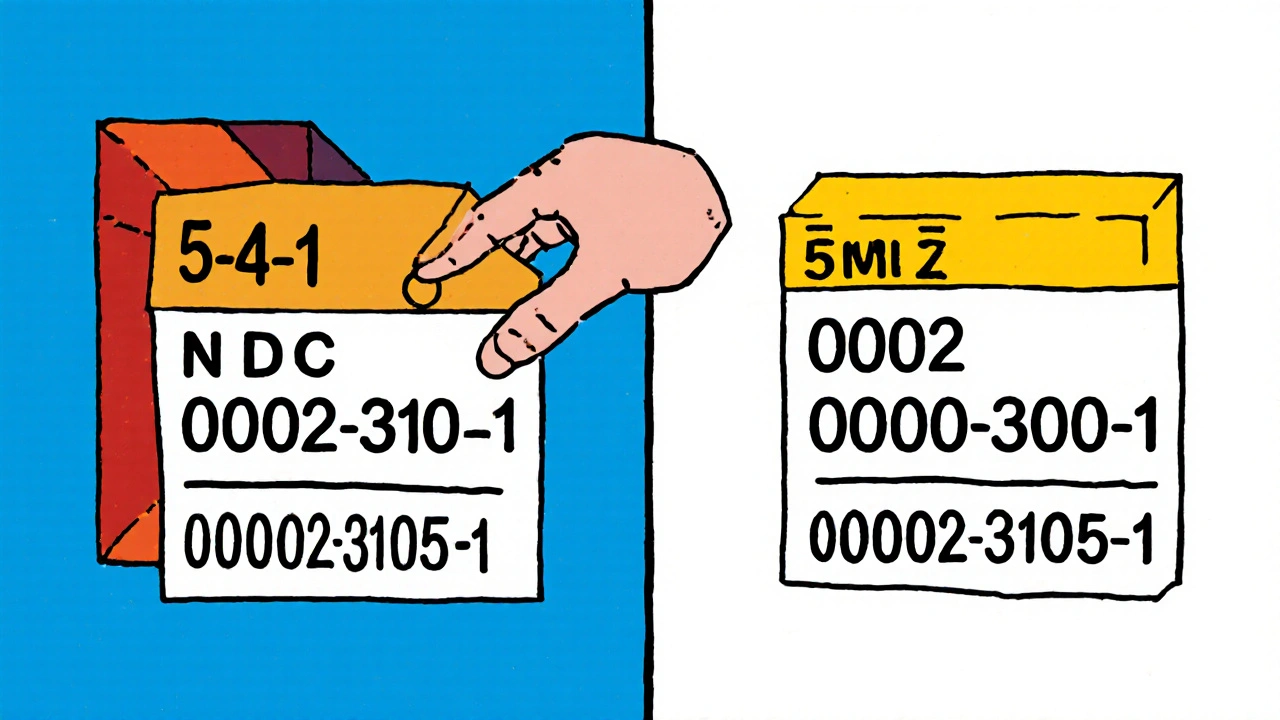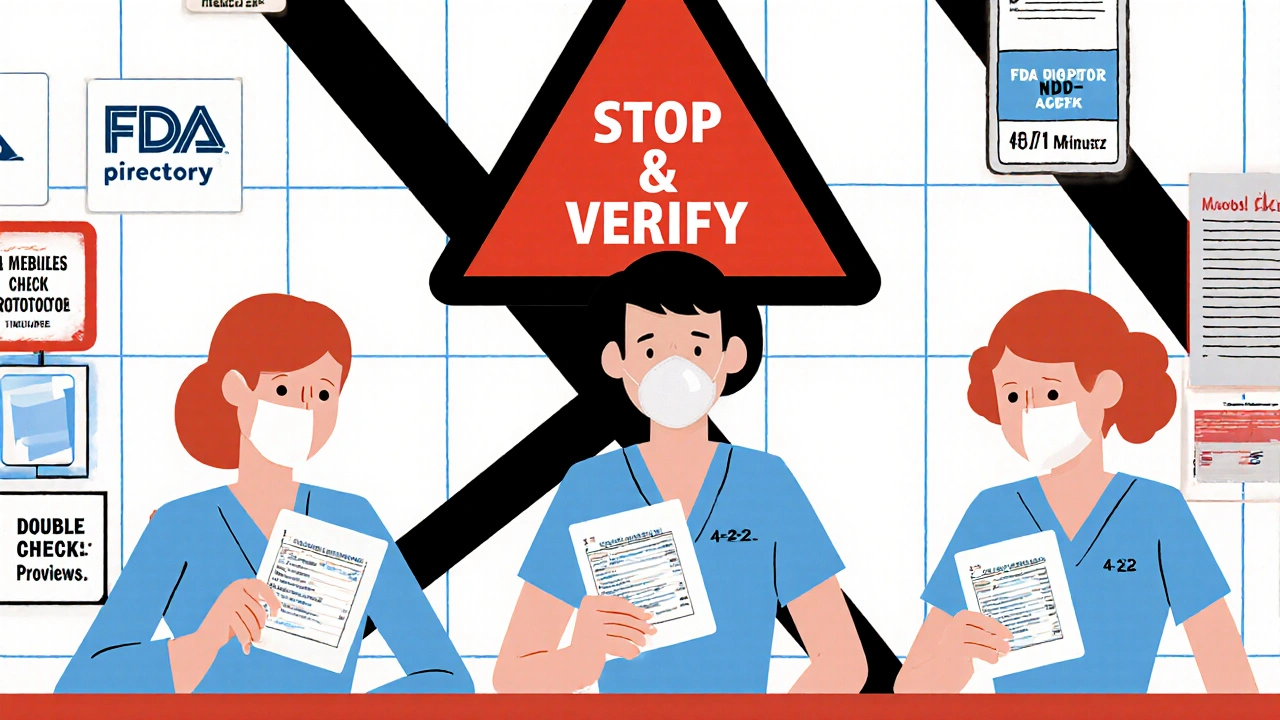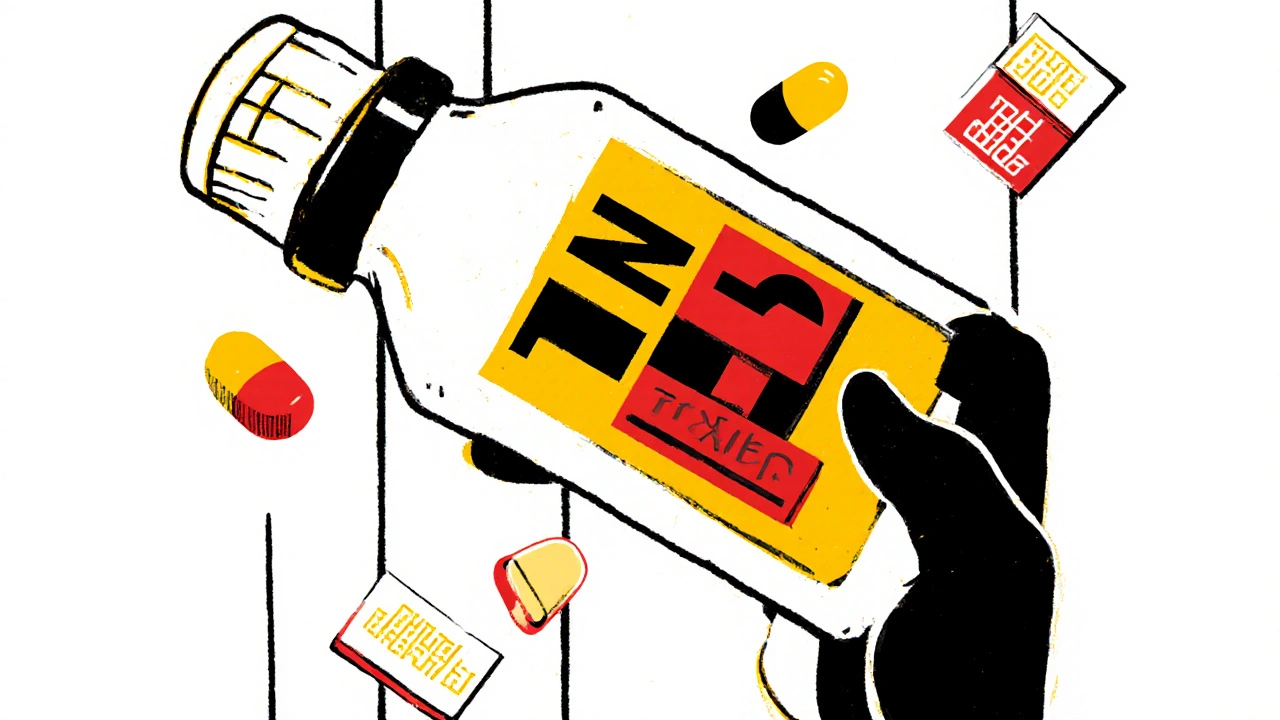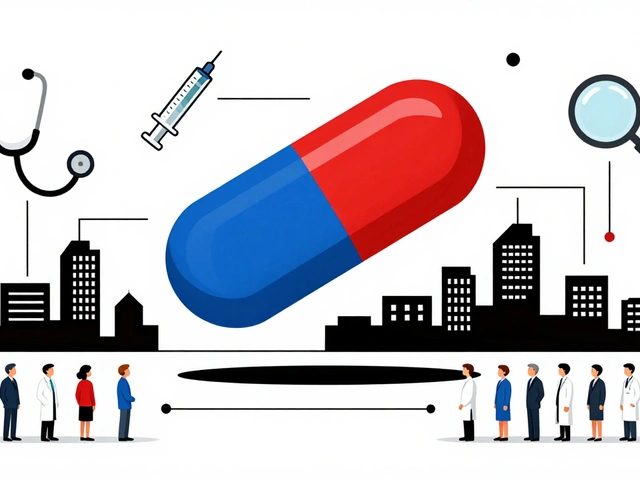Getting the right medication isn’t just about the name on the bottle. One small mistake in reading the NDC number can lead to a wrong dose, the wrong drug, or even a life-threatening error. In hospitals, pharmacies, and clinics across the U.S., the NDC number is the last line of defense before a pill goes into a patient’s hand. If you work in healthcare-whether you’re a pharmacist, nurse, technician, or even a caregiver-you need to know how to read it correctly. This isn’t theory. It’s daily practice. And it saves lives.
What Exactly Is an NDC Number?
The National Drug Code, or NDC, is a 10-digit number printed on every prescription and over-the-counter medication sold in the United States. It’s not just a barcode number-it’s a unique identifier that tells you exactly which drug it is, who made it, how strong it is, what form it comes in, and how many pills or milliliters are in the package.
The FDA created the NDC system back in 1972 under the Drug Listing Act. Since then, it’s become the backbone of medication safety. Every time a pharmacy fills a prescription, every time insurance processes a claim, and every time a drug moves through the supply chain, the NDC is used to track it. Without it, you’d be guessing.
But here’s the catch: the 10-digit NDC you see on the bottle doesn’t always match what’s entered into the computer. That’s because billing systems require an 11-digit version. You have to know how to convert it-and when to do it.
The Three Parts of the NDC Number
Every NDC is broken into three segments, separated by hyphens. Think of it like a phone number: area code, exchange, line number. Each part means something specific.
- Labeler Code (first segment): This is 4 to 6 digits long and identifies the company that made or repackaged the drug. It could be Pfizer, Teva, or a small local pharmacy that repackages bulk meds. The FDA assigns this code. There are about 3,500 active labelers right now.
- Product Code (second segment): This is 3 to 4 digits and tells you the exact drug, its strength, and its form. For example, if the product code is 3105, that might mean 10mg capsules of fluoxetine. Change it to 4465, and now it’s 20mg capsules. Same drug, different dose. Big difference.
- Package Code (third segment): This is 1 or 2 digits and shows the package size. A code of 02 might mean a bottle of 100 tablets. A code of 01 might mean a bottle of 30. If the prescription says 30 tablets but the NDC shows 100, you’ve got a mismatch.
These three parts together create a fingerprint for the medication. No two drugs have the same combination. That’s why you can’t just look at the brand name-you have to check the NDC.
How to Read the NDC Format
There are three possible formats for the 10-digit NDC:
- 4-4-2 (e.g., 1234-5678-90)
- 5-3-2 (e.g., 12345-678-90)
- 5-4-1 (e.g., 12345-6789-0)
You need to count the digits between the hyphens to figure out which one you’re looking at. Don’t assume. Don’t guess. Count.
Why does this matter? Because when you enter the NDC into a pharmacy system or insurance portal, you need to convert it to 11 digits in the 5-4-2 format. That’s the universal billing standard required by Medicare, Medicaid, and most insurers.
Here’s how to convert:
- If it’s 4-4-2 → Add a zero at the start of the labeler code → becomes 5-4-2
- If it’s 5-3-2 → Add a zero in the middle of the product code → becomes 5-4-2
- If it’s 5-4-1 → Add a zero at the end of the package code → becomes 5-4-2
Example: NDC 00002-3105-01 (5-4-1 format) becomes 00002-3105-01 → still 10 digits. To make it 11-digit billing format: add a zero to the package code → 00002-3105-01 becomes 00002-3105-01? No. Wait. The package code is 01 (two digits). So 5-4-1 means the last segment is one digit. That’s the issue. In this case, the package code is actually one digit: 1. So you add a zero → becomes 01. Final billing NDC: 00002-3105-01. Now it’s 5-4-2.
This is where mistakes happen. One extra zero in the wrong place, and the system rejects the claim-or worse, dispenses the wrong drug.

How to Verify the NDC Against the Prescription
Don’t just copy the number. Compare it to the prescription. Do this every time.
- Check the labeler code: Does the manufacturer match what’s on the prescription? If the script says “brand-name Prozac,” but the NDC is from a generic manufacturer, that’s fine-but you need to know it’s a generic. If the prescriber specified brand, you can’t substitute without checking.
- Check the product code: This is the most critical part. Match the drug name, strength, and dosage form. If the prescription says “fluoxetine 20mg capsule,” the product code must reflect that. A product code like 4465 means 20mg. 3105 means 10mg. Mixing them up is dangerous.
- Check the package code: Does the quantity match? If the prescription is for 30 tablets and the NDC shows a bottle of 100, you’re fine-you’ll dispense 30. But if the NDC says 10 tablets and the script says 30, you might be missing stock or have the wrong package.
Pharmacists in Sydney, Melbourne, and Chicago all use the same principle: if it doesn’t match, stop. Call the prescriber. Don’t guess.
Real-World Mistakes and How to Avoid Them
Here’s what goes wrong-and how to catch it:
- Mixing up product and package codes: One pharmacist in Arizona almost gave a patient 100mg of metformin instead of 500mg because they confused the product code (strength) with the package code (quantity). The NDC was 12345-678-01 (product code 678 = 500mg). They thought 01 meant 100mg. It didn’t. It meant one bottle. They caught it during double-check.
- Using the wrong format: A hospital in Ohio entered a 5-3-2 NDC as 5-4-2 without adding the zero. The system pulled up a completely different drug. The patient was on warfarin. The system showed a different anticoagulant. They caught it before it was dispensed.
- Not checking discontinued codes: The FDA deactivates about 8,500 NDCs a year. If you’re using an old label or outdated database, you might be looking at a code that’s no longer approved. Always verify against the FDA’s current directory.
Best practice: Always do a two-person check for high-risk medications like insulin, opioids, or anticoagulants. It adds 37 seconds per check-but it cuts errors by over 60%.

Tools to Help You Verify NDCs
You don’t have to memorize 150,000 NDCs. Use the tools.
- FDA’s NDC Directory: Free, updated daily. Search by NDC, drug name, or manufacturer. It shows active status, strength, form, and package size. Use it on your phone.
- Pharmacy software: Most systems auto-convert NDC formats and flag mismatches. But don’t rely on it blindly. Always cross-check the screen with the physical label.
- Mobile apps: Apps like NDC Lookup by FDA or Medscape’s drug database let you scan barcodes or type in the number and get instant verification.
- Double-check verbally: Say it out loud: “Labeler: zero-zero-zero-zero-two. Product: three-one-zero-five. Package: zero-one.” That’s fluoxetine 10mg capsules. If the next person hears “four-four-six-five,” they’ll catch the error.
Why This Matters More Than Ever
In 2023, the FDA reported that 12% of all medication dispensing errors were tied to NDC misreading. That’s one in eight mistakes. Most of them happen because someone rushed, assumed, or didn’t know the format.
And it’s getting more important. The Drug Supply Chain Security Act (DSCSA), fully active since November 2023, requires every prescription drug package to have a unique NDC for electronic tracing. If the NDC is wrong, the whole chain breaks. The drug can’t be tracked. It can’t be recalled. And if something goes wrong, no one knows where it came from.
Even worse: the FDA is moving toward a 12-digit NDC by 2025. That means the old formats will disappear. If you’re not comfortable with the current system now, you’ll be lost soon.
What to Do If You’re Still Confused
It’s okay. NDCs aren’t intuitive. They’re technical. But you don’t have to figure it out alone.
- Ask a pharmacist. They’ve seen it all.
- Call the FDA’s NDC hotline: 1-855-543-3784. They answer questions daily.
- Use the FDA’s NDC Directory website. Type in the number. See what it says.
- Don’t be afraid to pause. If you’re unsure, stop. Verify. Ask.
Medication safety isn’t about being perfect. It’s about being careful. And the NDC number is your most powerful tool.
What does the NDC number stand for?
NDC stands for National Drug Code. It’s a unique 10-digit identifier assigned by the FDA to every medication sold in the United States. It includes information about the manufacturer, drug strength, dosage form, and package size.
Why is the NDC number 11 digits for billing?
Insurance systems, including Medicare and Medicaid, require an 11-digit NDC in the 5-4-2 format for claims processing. The 10-digit label version may be 4-4-2, 5-3-2, or 5-4-1. To convert, you add a zero to the segment that’s too short to meet the 5-4-2 structure-either at the start of the labeler code, in the middle of the product code, or at the end of the package code.
Can two different drugs have the same NDC number?
No. Each NDC is unique to a specific drug, strength, dosage form, and package size. Even if two drugs have the same active ingredient, different strengths or packaging will have different NDCs. For example, fluoxetine 10mg capsules and fluoxetine 20mg capsules have different product codes and therefore different NDCs.
How do I know if an NDC is still active?
Check the FDA’s National Drug Code Directory online. It’s updated daily and shows which NDCs are active, discontinued, or withdrawn. Never rely on an old label or outdated database-always verify with the official directory before dispensing.
What should I do if the NDC on the bottle doesn’t match the prescription?
Stop. Do not dispense. Verify the NDC against the FDA directory. Confirm the strength, form, and manufacturer. If there’s a mismatch, contact the prescriber to clarify. Never assume the label is correct-even if it’s from a trusted supplier.





Shannon Hale
November 18, 2025 AT 12:43You people are still using 10-digit NDCs? Jesus. I’ve been screaming about the 11-digit billing format since 2019. If your system doesn’t auto-convert and flag mismatches, you’re not a pharmacist-you’re a liability with a badge. And don’t even get me started on those who assume ‘00002-3105-01’ is the same as ‘00002-3105-1’-that’s not a typo, that’s a death sentence waiting to happen.
Holli Yancey
November 18, 2025 AT 17:04I appreciate how detailed this is. I’m a new tech and I was terrified of NDCs until I read this. The breakdown of labeler/product/package made it click. I started writing them out loud like you said-‘zero-zero-zero-zero-two, three-one-zero-five, zero-one’-and now I catch errors before they happen. Small habit, huge safety net.
Gordon Mcdonough
November 18, 2025 AT 17:06THEY’RE MAKING IT 12 DIGITS NEXT YEAR?!?!?!?!?!!? I’M NOT A COMPUTER I’M A HUMAN BEING I JUST WANT TO GIVE PEOPLE THEIR MEDS WITHOUT DOING MATH ON A BOTTLE!! I’VE SEEN TOO MANY PEOPLE SCRAMBLE WITH THIS AND THEN THE FDA COMES IN AND SAYS ‘OH BY THE WAY WE CHANGED THE RULES AGAIN’ AND THEN SOMEONE GETS THE WRONG DRUG AND THEN I’M THE ONE IN COURT!!
Jessica Healey
November 20, 2025 AT 03:23omg yes!! i just had a patient yesterday come in because her script said fluoxetine 20mg but the bottle said 10mg and the NDC looked the same until you counted the digits. i almost didn’t catch it because i was rushing. now i read it out loud every time. also, the FDA app is a lifesaver. i use it while i’m waiting for the copay to process.
Levi Hobbs
November 21, 2025 AT 00:16Great breakdown-thank you. I’ve been in pharmacy for 12 years and I still double-check the format every time. One time, I saw a 5-3-2 NDC and assumed it was 5-4-2. The system didn’t flag it. I caught it because the package size didn’t match the label. Now I always count the digits before I enter anything. It’s not about trust-it’s about verification.
henry mariono
November 21, 2025 AT 18:18This is the kind of post that reminds me why I chose this field. I’ve seen what happens when people skip steps. I don’t comment often, but I’m glad someone took the time to write this clearly. I’ll be sharing it with my new hires tomorrow.
Sridhar Suvarna
November 22, 2025 AT 11:38In India, we don't have NDC, but we have unique drug codes too. The principle is the same: verify before you dispense. I work in a rural clinic. One wrong dose can kill someone who can't reach a hospital. This post is universal. Thank you for writing it with such clarity. Safety is not a policy-it is a habit.
Joseph Peel
November 24, 2025 AT 01:07The shift to 12-digit NDCs is inevitable. The DSCSA isn’t just bureaucracy-it’s traceability. If we can track a package of coffee beans from farm to cup, we can track a vial of insulin from manufacturer to patient. This isn’t about compliance. It’s about accountability. And if you’re resisting it, you’re resisting progress.
Kelsey Robertson
November 24, 2025 AT 05:25Wait-so you’re telling me the FDA created this whole system to make pharmacists’ lives harder? And now they’re going to 12 digits? What’s next? NDCs written in Braille on the pill bottles? This isn’t safety-it’s performative bureaucracy. You think a nurse in a rural ER really cares if the labeler code is 4-4-2 or 5-4-2? She cares that the patient gets the right damn pill. Stop overcomplicating things.
Joseph Townsend
November 26, 2025 AT 00:43Let me tell you about the time I almost gave a patient a 100mg metformin instead of 500mg because the package code looked like a strength code. I was in the middle of a 14-hour shift. My coffee was cold. My eyes were burning. And I almost killed someone because I didn’t count the digits. I didn’t cry. I didn’t quit. I just started saying every NDC out loud-like a prayer. And now? I don’t trust my eyes. I trust my mouth. And I’ll never stop.